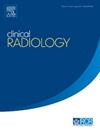Comparison of perfusion defects parameters in dual-energy computed tomography (CT) pulmonary angiography across arterial phase and venous phase
IF 2.1
3区 医学
Q2 RADIOLOGY, NUCLEAR MEDICINE & MEDICAL IMAGING
引用次数: 0
Abstract
AIM
This study aims to compare dual-energy computed tomography pulmonary angiography (DE-CTPA) perfusion defects (PD) parameters between the arterial (AP) and venous phases (VP).
MATERIALS AND METHODS
This retrospective study analysed the database of patients who underwent dual-phase DE-CTPA examinations. The patients were categorised into three groups based on their Qanadli (Q) scores (Group A: Q = 0%, Group B: 0% < Q < 50%, and Group C: Q ≥ 50%). PD parameters, including perfusion defect volume (PDV) and its percentage relative to total lung volume (RelPDV), were derived from the dual-phase DE-CTPA images. Differences in PD parameters were assessed between phases and among the three groups.
Results
A total of 81 consecutive patients were included in the study (44 females [54.3%]; mean age: 68.37 ± 13.01 years). RelPDV was significantly higher in the AP compared to the VP (P0.030). Phase comparisons within each group showed no statistically significant differences in PDV between the AP and VP for Group C. However, in Groups A and B, both PDV and RelPDV were higher in the AP than in the VP (all P<0.05). When comparing the three groups, there were no statistically significant differences in PDV or RelPDV for AP. In VP, PDV, and RelPDV increased with higher Q scores, with Group C showing statistically significant differences compared to Groups A and B.
Conclusion
The PD parameters of DE-CTPA differed between AP and VP. This study highlights the limitations of relying on iodine maps in AP to estimate lung perfusion.
双能CT肺血管造影在动脉期和静脉期灌注缺陷参数的比较
目的本研究旨在比较双能肺血管造影(DE-CTPA)灌注缺陷(PD)参数在动脉期(AP)和静脉期(VP)之间的差异。材料与方法本回顾性研究分析了接受双期DE-CTPA检查的患者数据库。根据Qanadli (Q)评分将患者分为三组(A组:Q = 0%, B组:0% <;问& lt;C组:Q≥50%)。PD参数,包括灌注缺陷体积(PDV)及其相对于总肺体积(RelPDV)的百分比,来自双期DE-CTPA图像。评估不同阶段和三组之间PD参数的差异。结果共纳入81例患者,其中女性44例,占54.3%;平均年龄:68.37±13.01岁)。AP组RelPDV明显高于VP组(P0.030)。各组间期比较显示,c组AP组和VP组的PDV无统计学差异。而A组和B组AP组的PDV和RelPDV均高于VP组(p < 0.05)。三组比较,AP的PDV、RelPDV差异无统计学意义。VP、PDV、RelPDV随Q评分的升高而升高,其中C组与A、b组比较差异有统计学意义。结论AP与VP DE-CTPA PD参数存在差异。本研究强调了依靠AP碘图来估计肺灌注的局限性。
本文章由计算机程序翻译,如有差异,请以英文原文为准。
求助全文
约1分钟内获得全文
求助全文
来源期刊

Clinical radiology
医学-核医学
CiteScore
4.70
自引率
3.80%
发文量
528
审稿时长
76 days
期刊介绍:
Clinical Radiology is published by Elsevier on behalf of The Royal College of Radiologists. Clinical Radiology is an International Journal bringing you original research, editorials and review articles on all aspects of diagnostic imaging, including:
• Computed tomography
• Magnetic resonance imaging
• Ultrasonography
• Digital radiology
• Interventional radiology
• Radiography
• Nuclear medicine
Papers on radiological protection, quality assurance, audit in radiology and matters relating to radiological training and education are also included. In addition, each issue contains correspondence, book reviews and notices of forthcoming events.
 求助内容:
求助内容: 应助结果提醒方式:
应助结果提醒方式:


